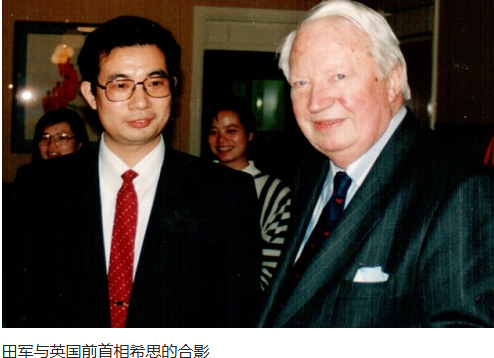Executive Summary
Tian Jun, born in 1957, presents a highly illustrative case of how the Chinese Communist Party (CCP) has systematically groomed cadres through military-industrial structures and then deployed them abroad as part of long-term influence and intelligence efforts. From his early roots in a PLA-controlled weapons factory to his prominent roles in the UK’s financial and energy sectors, Tian’s career arc raises substantial concerns for Western counterintelligence and policy planners.
Timeline and Background
Pre-1978: Tian Jun worked as an apprentice at “Factory 6410,” a military industrial complex located in the remote Taihang mountain region, specifically in Jingxing County. This facility, a massive enterprise directly under the PLA Armored Forces and rated as a full division-level unit, was considered a model of red-military industry integration. Tian himself stated that his aspiration at the time was to one day live in the factory’s “Generals’ Building.”
1978: On September 25, his 21st birthday, Tian received admission to Peking University’s World Economics program. This was shortly after Deng Xiaoping’s rise and the official start of the “Reform and Opening Up” campaign. He claimed to have chosen this major because it best reflected the ideological direction of the era.
1982: After graduating, Tian joined the State Price Bureau and later worked with key economic planning bodies such as the State Planning Commission and the State Council’s Price Research Center.
1985-1988: Tian was deeply involved in the ideological and policy-oriented campaigns of the time. He published widely on price reforms and edited volumes for the State Council. He was considered one of the rising young economic thinkers in Beijing’s political scene.
1988: He was sent to the UK to study under Nicholas Stern (later Lord Stern) at the University of London, earning a PhD in Economics. This coincided with a strategic window as China prepared for Hong Kong's handover and dispatched cadres abroad.
Professional Trajectory in the West
1994: Tian joined Crosby-MTM Investment Bank in London’s financial district, working as a senior consultant and vice president. He advised over 20 major multinational clients, including BP, BT, and BAA.
1999: He joined Fortune Oil PLC, a London-listed energy firm with substantial operations in China, Central Asia, and the Middle East. Tian quickly rose through the ranks:
1999: Executive Director
2006: Chief Operating Officer; concurrently Chairman of Fortune Gas
2012: Group CEO
Under Tian’s leadership, Fortune Oil became a core shareholder of Hong Kong-listed China Gas Holdings (384.HK), operating over 500 subsidiaries in mainland China. The company also formed joint ventures with China Aviation Oil to service over 30 airports in South China.
Parallel Influence Networks and Allegiances
Tian was active in Chinese Communist-aligned diaspora networks in the UK, including the Chinese Economic Association (UK), which has been identified as a United Front-aligned organization facilitating influence operations and elite co-optation.
He served in various capacities across CCP-affiliated enterprises and media vehicles, such as:
Chairman, Zhongshi Boya Brand Innovation Incubator
Executive Chair, Financial Guest (金融客)
Chairman, Unnamed Cooperative & Vineyard in China
Investor in multiple PRC-based fintech and cultural ventures including Tianhong Fund (operator of Yu’E Bao with Alibaba)
He also chaired or invested in entities supporting large-scale media penetration, such as CTV's main advertising agency, helping deploy CCP messaging through CCTV2, CCTV4, and other channels.
Analytical Implications for Western Security Planners
Tian Jun’s trajectory is not merely the story of a successful overseas Chinese executive. It is a textbook case in how PLA-origin personnel—trained, trusted, and embedded in military-industrial-political organs—are rebranded as foreign professionals to achieve strategic depth for the Chinese state. Key characteristics of concern:
PLA-Groomed: Tian’s work in a division-level military industrial unit prior to university education places him squarely within the PLA’s loyalty network.
Policy Engineer: His 1980s activity in pricing reforms and ideological campaigns mark him as more than a technocrat—he was a party-aligned operative shaping narratives.
Transnational Leverage: His cross-border capital activity and control over media, finance, and infrastructure firms gave him tools for economic and political influence.
United Front Linkages: Engagement with the Chinese Economic Association (UK) and similar groups mirrors known patterns of CCP political warfare tactics abroad.
Recommendations for Western Governments
Personnel Vetting: Reassess all individuals who originated from PLA-run or central CCP planning bodies, even if they appear to have naturalized or established long-term residence.
Diaspora Network Monitoring: Investigate organizations linked to the United Front Work Department or other “soft influence” arms of the CCP, particularly those involving academic and business exchanges.
Sectoral Risk Review: Identify strategic sectors (e.g., energy infrastructure, media, fintech) where such individuals hold influence and consider countermeasures.
Public Awareness: Disseminate sanitized versions of these case studies to both the public and private sectors to break the illusion that such figures are benign economic actors.
Conclusion
Tian Jun’s path—from PLA apprentice to London energy executive—offers a disturbing but clarifying insight into how the CCP deploys long-term infiltration through ostensibly legitimate career progressions. His presence in high-leverage sectors and close alignment with Party-state agendas demands a full-spectrum counterintelligence response.
Sources: Peking University records, Zhihu articles, CEAC UK website, Baidu Baike entries, and archived publications.

No comments:
Post a Comment